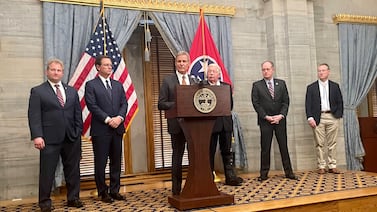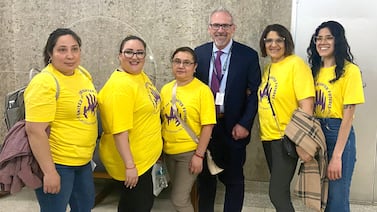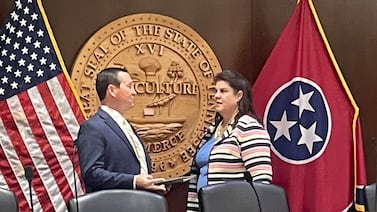As Colorado school districts braced for budget cuts, Gov. Jared Polis gave them a $510 million lifeline in the form of federal coronavirus relief money. School district administrators around the state say they’re grateful, but also struggling with the restrictions that come with the money.
Polis has said repeatedly that he intends to give districts as much flexibility as possible, but federal rules deem that it be used by the end of the calendar year for purposes related to COVID response. The Colorado Department of Education has yet to issue guidance specific to this pot of money, though it has weighed in on another pot of federal money for K-12 schools.
“The last thing I want to do is get time for the audit, and they say, ‘Oh, you have to send this money back because you didn’t use it right,’” said Tom Satterly, superintendent of the Burlington district on Colorado’s eastern plains. “That would be devastating. I get tired of hearing, ‘be creative.’ I’ll get creative and have to send back $400,000.”
The money comes from the state’s $1.67 billion in federal relief money to cover COVID response and economic recovery. In an executive order, Polis gave $510 million to the state’s K-12 schools and specifically connected it to the state’s economic recovery. The executive order mentions improving remote learning, helping schools follow public health measures, facilitating social distancing, and making up for lost learning during school closures as among the allowed uses.
“The allocation to school districts is not as flexible as state funding, but we look forward to working with them to make sure they can use every dollar by the end of the calendar year in ways that are allowed under the CARES Act and consistent with their needs,” Polis said.
The legislature has seized on the CARES Act allocation to downplay the impact of state budget cuts. The state plans to spend about 15% less on K-12 education next year, and average per pupil spending will go down by about 5%, though the impact on each district varies. The federal money cannot be used to backfill or offset cuts to general operating expenses.
Tracie Rainey of the Colorado School Finance Project said districts feel confident spending the money on one-time expenses associated with remote learning or making schools safer, whether that’s a new online curriculum or cleaning supplies. They’re less sure how to apply the money to account for new ways of teaching and organizing the school day. Could it be used to pay salaries if, for example, a teacher has a longer work day because students are coming into class in two groups to allow for social distancing?
“What complicates it more is that these funds aren’t coming from the (federal) Ed Department,” Rainey said. “They’re coming from the Treasury Department, and they’re not easily transferable to the K-12 setting.”
Satterly said he would love to use the money to keep classroom aides, nurses, and counselors in Burlington schools. These are the types of positions that sometimes aren’t filled or even get cut in tough economic times, and they are important to improving the learning experience and keeping students healthy, physically and emotionally.
But without reassurance that will be allowed, he’s not sure he can spend his entire $500,000 allotment by the end of the year, even as he’s preparing to cut 15%-20% of Burlington’s $6.5 million annual budget.
Denver district officials have faced questions from union members about why they aren’t using more of their CARES Act allocation to bolster staffing in nursing, mental health, and custodial services. The district faces a $61 million shortfall in its $1.1 billion budget and expects to get between $45 million and $50 million from the governor’s CARES Act allocation.
“It’s pretty unlikely we could just say all this money is going to fill the hole that we have,” the district’s Chief Operating Officer Mark Ferrandino said at a recent meeting of the budget advisory committee. “We are going to have to justify this. It’s very clear from the federal requirements that you can’t use this for existing expenses that you had in your budget. The question is, how flexible is that?”
The Aurora school district so far is estimating a 4% loss in state revenue, or about $23 million, to its general fund of just under $600 million. Meanwhile, the district received about $26.8 million from the governor’s CARES Act allocation.
“If we can’t use CARES Act dollars in a very flexible manner, the revenue or overall budget may be worse,” said Brett Johnson, the district’s chief financial officer.
Another concern for schools is that the CARES Act money is just for this year. If officials use the money to avoid making cuts for the coming school year, they could face even bigger cuts the following year.
That’s not to say districts don’t have plenty of costs directly related to the pandemic. Some are planning classroom modifications to allow for social distancing or trying to improve online instruction. Many Colorado school districts never fully solved their students’ technology and internet access problems during spring closures. They’ve been told to prepare for a mix of in-person and online learning in the fall and can’t afford to leave students disconnected.
“Our technology infrastructure is not near that of some districts,” said Shae Martinez, chief financial officer of the Commerce City-based Adams 14 district. “We were able to deploy about 4,000 devices when we went to remote learning, but we are in dire need of more technology.”
That includes discussions with Comcast about how to get more families internet from their home, she said.
Adams 14 may also pay salaries for some mental health staff who will be addressing COVID-19 related trauma or give employees hazard pay or bonuses for working from home. But at the same time, the district will have to find savings in other places.
So far, the Commerce City-based district is projecting about an 8% loss in revenue, or about $5 million, to its approximately $70 million general fund budget. The governor’s CARES allocation will bring the district $5.7 million.
The CARES money comes with restrictions, while the $5 million in lost state revenue could have gone toward any district expense.
“You did lose that revenue and that’s a fact — and you can’t use this [federal grant] the same way,” Martinez said.








